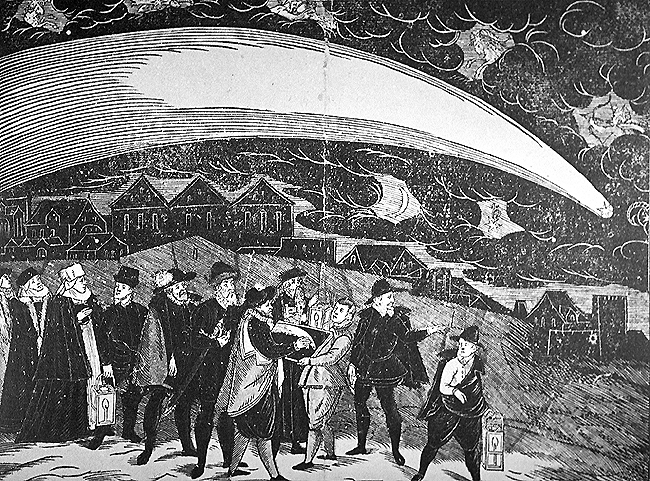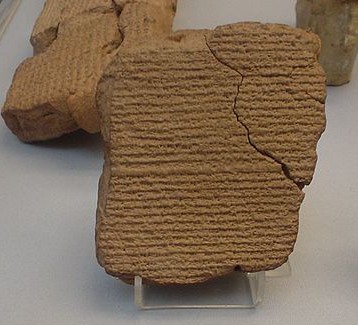As a re-entry activity, let’s fall right into the project which inspired the overarching theme for this so-called blog: cometary tails. That is, in this instance, we’ll be “studying” the behavior of the tails of actual comets falling along their orbits about a star. But of course, this is a “Messy Monday” project, so it involves running, arguing, and playing with scissors (not all at the same time).
So far, the only star whose comets we’ve observed have been those of our own Sun, but as our star is not particularly unusual, it’s likely that comets ply their trade throughout the cosmos. We’ll not be delving too deeply into astrophysics, instead we’ll be building fun models of comets and playing games which illustrate the apparent motion of a typical comet’s tail. If you’re running this project as part of a school science program, you can double-count the activity as a P.E. session, as the central game involves more than a bit of running, though not likely moving as fast as a comet.
Just as a reminder, what I want to give you in these “Messy Monday” project descriptions is 1) enough background on the science that you’ll be prepared for questions and have resources to draw on if your own curiosity is triggered, 2) a play-by-play description of running the project with a group, recognizing that your time and resources are limited and your participants will vary in both interest and prior knowledge, and 3) a shopping list detailed enough to help you minimize your costs as well the time you have to spend assembling supplies.
So, What Do You Want to Know?
For thousands of years, humans have wondered at the strange visitations of comets.
In our time, people now understand that comets are not harbingers of doom or annunciations of the births of kings but fellow travelers in our solar system, icy bodies wheeling in towards the sun and shedding a fraction of their substance as they approach the sun. However, a key aspect of the comet’s tail remains counterintuitive to us earthbound air-dwelling creatures. The tail of a running horse flows behind her as she gallops, so we naturally expect that the tail of comet simply flies behind it as it plunges along its course. But a comet’s behavior plays tricks with such expectations.
Where do comets come from? The Solar System is a big place, but for most of us, the territory ends with Pluto, the Object Formerly Known as The Ninth Planet.
However, if you’re a fan of Cosmos (either Carl Sagan’s or Neil DeGrasse Tyson’s version) or if your school is lucky enough to have new textbooks, then you’ll know about the Oort Cloud , that sphere of orbiting material from which most comets emerge. Do you realize how much farther out this region is? On a scale of one inch per 100,000 miles, in which the orbit of Pluto would be one mile across, the distance from the Sun to the Oort Cloud would be the length of the state of California. It’s even been hypothesized that the Oort clouds of neighboring stars may physically interact, exchanging comets.
The Oort cloud is a long way out, but it’s still a part of the Solar System, because the objects there are still subject to the Sun’s gravity. Occasionally, a piece of this clutter is jostled from its orbit and begins the long fall towards the sun. Depending on the path it takes as it zooms around the sun, the comet may slingshot out of the solar system entirely or it may settle into a new orbit, returning to loop around the sun on a regular schedule. For instance, Comet Halley returns every 86 years. The last time round, it actually came in ’86–1986 that is. I was lucky enough to visit New Zealand that year, so I can confirm that Comet Halley was extremely unspectacular that year–only just barely visible. Fortunately, New Zealand itself is spectacular every single day of any given year. NASA was more successful, having a noticeable advantage in telescope access.
But why do comets even have tails? We don’t see shiny tails glowing in the wakes of our planets. Well, it all has to do with the change in environmental conditions as the comet moves towards the Sun. Comets are composed of water ice, frozen gases, rocky matter, and even traces of organic compounds. As this frozen jumble approaches the sun, it warms up enough that the various ices in the outer layers of the comet become gaseous—water vapor, ammonia, carbon dioxide. These gases bubble and boil into a misty cloud, so the comet will have an atmosphere of sorts, called the coma, for the duration of its passage through the inner Solar System. The gas expulsions may even shoot out of the comet’s rocky layers like jets, causing the comet itself to tumble as it falls along its inward path. At the same time, very small-scale “dust” particles are swept from the cometary nucleus. This is not the heavily-organic dust we find under our furniture here on Earth (if you really want to know what’s in household dust don’t use “Google images”; stick to text searches or just ask your friendly neighborhood allergist). What we mean is that the particle size—a few microns—is extremely fine, about the same size as the particles in cigarette smoke.
We get our fabulous cometary tail once these newly-ejected gases and dust of the coma approach the sun just a bit closer, enough that the various solar emissions can have their ways with the comet’s atmosphere. First, there is sunlight itself, which acts in several ways to provide us with the visual spectacle of the comet’s tail.
The simplest role of sunlight is to shine on the cloud of dust ejected from the nucleus. That’s the main tail we see. But that still doesn’t explain why the dust forms a tail at all: the secret is that light, as electromagnetic radiation, actually exerts pressure on objects, and with tiny objects like cometary dust this radiation pressure force is enough to fan that material out from the core. Plus, there is a cool bonus “secret”: that most comets actually have two tails—one formed by the gases and one formed by the dust. The ultraviolet radiation in sunlight blasts the gas particles, stripping away electrons, and so creating a mass of ionized gas, which fluoresces (mostly blue) in sunlight. Then those glowing blue ions are blasted in a straight line away from the sun by the solar wind, a stream of high-energy particles hurtling at supersonic speeds through the solar system. The solar wind is a wonderfully intricate system in its own right, but for our purposes here it is most important to convey that, like earthly winds, it consists of particles moving at high speeds and that its direction is away from the Sun.
The result of all these combined forces is that a complex, continuously shifting cloud of gases and dust streams out from a comet during its time in the inner solar system and that tail—or, rather, pair of tails—points away from the sun, even when the comet is on its way back out to its origin. (If you’re a die-hard comet enthusiast, you’ll know that the dust tail does curve inward a bit, as the small particles of dust battle with the solar forces, striving to curl into their own individual orbits about the sun, but from our earthly perspective, the outward forces have the upper hand.)
In the next installment, we’ll get down to the nitty-gritty of building our own comet models and playing a game of As the Comet Tail Flies.
Oh, yeah, and I’m not making things up about radiation pressure. Consider the prospects for spaceflight under the power of light!








